Xiaomi Redmi Note 10 Pro review: All hail the mid-range king
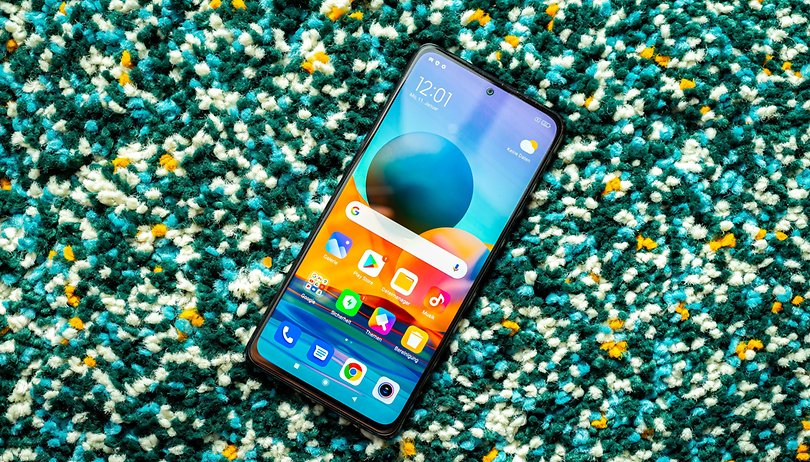

Xiaomi brings a breath of fresh air to the mid-range smartphone market with the all-new Redmi Note 10 Pro. With a 120 Hz display, a 108 MP camera, and a bunch of other attention-grabbing specs, does the phone manage to set a new benchmark under the €300 price tag? Read our review to find out!
Good
- Great build quality
- Ecxellent 120 Hz AMOLED display
- Solid performance
- Good main camera
- Good battery life
- Triple slot for dual SIM + microSD
- NFC
- Loud stereo speakers
Bad
- Somewhat bulky camera hump
- Camera performance drops in low light conditions
- No 5G support
- No wireless charging support

My brief opinion on the Xiaomi Redmi Note 10 Pro
Another boring €300 smartphone, huh? No! Far from it, my friends! What Xiaomi offers with the Redmi Note 10 Pro is a mid-range extravaganza. The display itself is not too far removed from flagship devices, courtesy of the 120 Hz refresh rate, while sporting fantastic color fidelity and brightness. In addition, there is a camera that performs really well, at least during the day, although it does seem that the 108 MP main camera is more marketing hype than an actual evolution in the right direction.
The battery capacity is large enough to last you an entire day and then some, while the stereo sound pumped out is loud and clear most of the time. With the Snapdragon 732G chipset running underneath the hood, it should satisfy more than just average users. On top of that, the build quality is very decent at this price range. Fortunately, there is also room for both a 3.5 mm jack and microSD memory card slot for expansion purposes.
Xiaomi offers all these for €279.90 Euros (~$279) and thus sent an opening salvo to other smartphone manufacturers as to what they are up against in 2021 if they want to claim top spot in the sub-€300 handset market.
Design: Large but functional
What I liked:
- High-quality workmanship
- Triple slot for dual SIM and a microSD card
- 3.5mm audio jack
What I didn't like:
- Camera hump is a bit too large
- Fingerprint magnet
I received the Onyx Gray version of the Redmi Note 10 Pro for my review and setting my gaze upon it, I was immediately taken by the high-quality workmanship. The build quality is impressive without any noticeable gaps in between the case and buttons. The buttons themselves had a nice feel to them. The side-mounted fingerprint sensor was quick and reliable. The phone also excelled at attracting fingerprint smudges. So keep that in mind before you go out and splurge your hard-earned money on this phone.
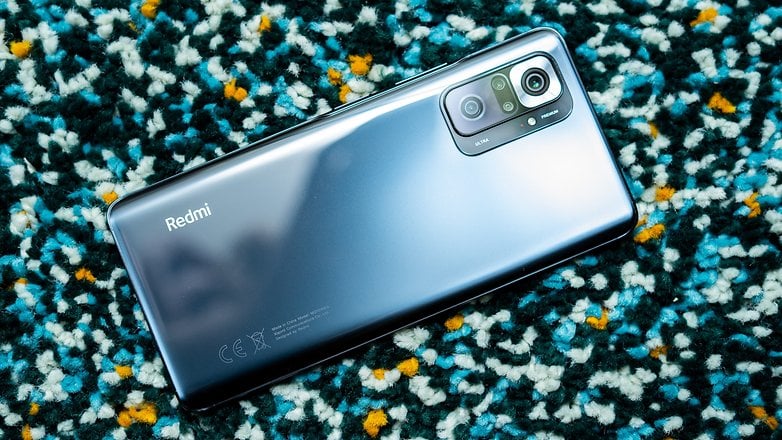
What's pleasing about this device is the fact that there is so much to check out with many of the well-implemented design nuances. Apart from the power button/fingerprint sensor and the volume control, we find a speaker located at both the top and bottom, with the much loved 3.5mm audio jack for headphones, and a slot that is tucked away on the left side which offers space for two SIM cards as well as a microSD memory card, now how about that? The way smartphones are being designed these days, it does seem as though they are ditching the microSD memory card slot for good.
Visually, the only thing that bothers me is the protruding camera bump behind, which means you can never lay the smartphone flat on its back on a table. If you have small hands, you will certainly have trouble grappling with the 6.7-inch form factor, and even if you have large hands like me, one-handed operation is not recommended.
A very visually appealing smartphone with an unsightly camera bump and an above-average build quality.
THIS is how a display in a mid-range smartphone should be
What I liked:
- 120 Hz display
- AMOLED screen
- actually, everything else about the display!
What I didn't like:
- Only two options for the refresh rate - 60 or 120 Hz
- The "sometimes-on" display
When it comes to smartphone displays in 2021, the premium range is defined as having a 120 Hz refresh rate and an AMOLED screen. Xiaomi has settled for nothing less than that with its 6.67-inch behemoth, and is certainly making quite a statement for itself with the Redmi Note 10 Pro's screen. They are basically barging into high-end and flagship territory with a menacing look, asking the question, "Hey boys, did you see what I've done here?"
Here is the other information about the display: this 6.67-inch AMOLED "DotDisplay" sports a resolution count of 2,400 x 1,080 pixels, which corresponds to a pixel density of 395 ppi. The panel also boasts of a 240 Hz sampling rate, HDR-10 support and a maximum brightness of 1,200 nits.
In less technical terms for the layperson: The higher the refresh rate, the smoother the display shows everything, and this is most evident when you are scrolling through long lines of text or social media streams. The display itself is still easy to read under bright sunlight while the color fidelity leaves nothing to be desired, just like the contrast.
If you like, you can go into the settings and adjust the color temperature according to your own visual requirements.
I've now thought about whether this display has any weaknesses. If there really is something to nitpick about, then it would have to be something that is extremely petty. I suppose that would be the 'fact' that I can only choose between 60 Hz and 120 Hz refresh rates. In addition, while the always-on display is an option right from the get-go, it doesn't really offer any useful visual information and turns itself off after ten seconds. You can then see it again with a tap of your finger - I opted for the phrase "Hands off my smartphone, asshole", which can be seen as soon as someone taps the dark screen once. Of course, with just a ten-second window to display this text, I guess you can dub this feature as a "sometimes-on" display at best, or even an "almost-never-on" display.
Those who want to buy a mid-range smartphone that has the best possible display would do well to pick the Xiaomi Redmi Note 10 Pro, no question about it.
Performance and memory
What I liked:
- Solid performance
- No excessive overheating
- Expandable memory
What I didn't like:
- No 5G support
Depending on the version that you picked, you will have either 6 GB or 8 GB of RAM and between 64 GB and 128 GB of internal storage. For my review unit, I received the model with 128 GB of storage and 6 GB of RAM. In my opinion, the industry should slowly back away from 64 GB of storage space for entry-level devices since it is not quite enough for today's needs, but thankfully there is a microSD memory card slot for expansion purposes.
Compared to the Snapdragon 720 that powered its predecessor, the Redmi Note 9 Pro, the Snapdragon 732G is now utilized here. It is worth every penny for this processor upgrade due to the higher clock speed of the Adreno 618 GPU. The eight cores work quietly in the background and combined with the 120 Hz display, the performance is so snappy that it's hard to believe that we're dealing with a 7 series Qualcomm SoC.
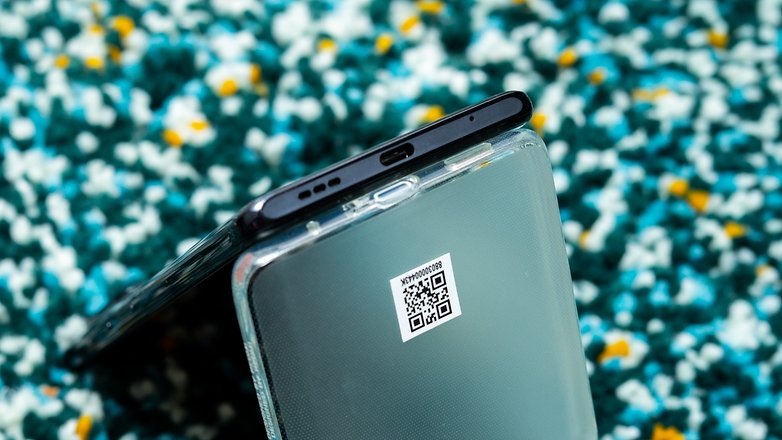
During my review, I once again took a stab at popular mobile games such as Call of Duty Mobile, Real Racing 3 and Genshin Impact as a real world test, and rarely encountered any dropped framerates. I'll go out on a limb and say that the average smartphone user won't have any problems with gaming performance. By the way, this also applies to image processing, which used to be a sore point in the past. Even at 108 megapixels, the smartphone still manages to process the photo swiftly quickly (approximately 'one second' in my opinion).
Xiaomi also offers an all-round package in terms of performance and storage. Even the 64 GB internal memory in the cheapest model does not detract its attractiveness due to the microSD memory card slot. Social media users as well as gamers should be happy with the Snapdragon 732G's performance.
Redmi Note 10 Pro camera: too good for a mid-range phone
Did someone just say "camera"? Oh yes, that was me! Let's talk about the camera that Xiaomi has included with their latest device.
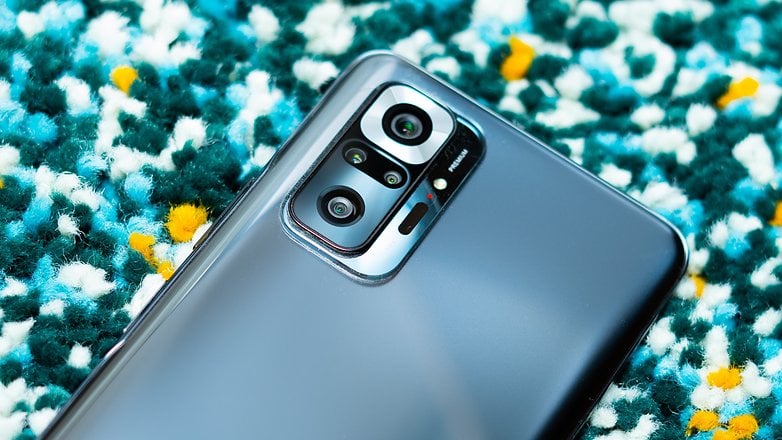
What I liked:
- Realistic, detailed photos in daylight
- Decent macro shots
- Versatile camera
What I didn't like:
- No optical image stabilization
- mediocre results in low light conditions
First of all: We have camera freaks like Ben or Stefan on our editorial team, who always focus on the camera performance in their reviews. When buying a smartphone, I also make sure that the camera isn't a total failure, but I'm more of a regular user who takes the occasional party pictures here and there (Party? What was that again?) and who makes use of a few cheap filters so that all uploaded photos are Insta-worthy. So don't be surprised if I don't write any novels in the camera section of this review. If you have any other questions about the cameras, feel free to ask them in the comments, I still have the smartphone here for a few more days to get back to you.

The main camera (f/1.79) has a resolution of up to 108 megapixels. To be honest, the results of a 108 MP camera didn't really blow me away. Sure, you can zoom into the pictures nicely, but that is too much of a software gimmick for me as the results tend to be somewhat washed-out and less realistic. Normally, nine pixels at a time are lumped together thanks to pixel binning, resulting in a 12MP image.
Also on board with the rest of the rear cameras are: An ultra-wide angle lens (118-degree shooting angle; f/2.2) with 8 MP, a telephoto macro camera (f/2.4) with 5 MP and 2x magnification, and finally a depth sensor (2 MP).

If the weather co-operates, you'll obtain really fine results with this camera. When I switched to the ultra-wide-angle camera, I notice that the color palette shifts a bit, and I personally found such images too saturated. Also, details tend to go missing when I zoom into the pictures.
With a bit of skill, you can take some nice macro shots with the telemacro lens, while the portrait mode doesn't disappoint either.

I'm always inclined to find fault with the results, but then I reminded myself that I'm holding a smartphone that retails for less than €300. At that price point, the photos captured are excellent. I don't think any other smartphone within this price range can perform better than Xiaomi and their Redmi Note 10 Pro at the moment.
To back up this claim, I have a few more sample photos taken by the camera as seen below:

From the following cherry blossom photos, you can see that:
- ... it is not always grey in Dortmund
- ... cherry blossoms are simply a great subject
- ... the author of the review seems to have a real cherry blossom photo fetish
- ... the camera achieves great results in such situations
- ... fewer cars should be allowed within the inner city - and not just because they are an eyesore
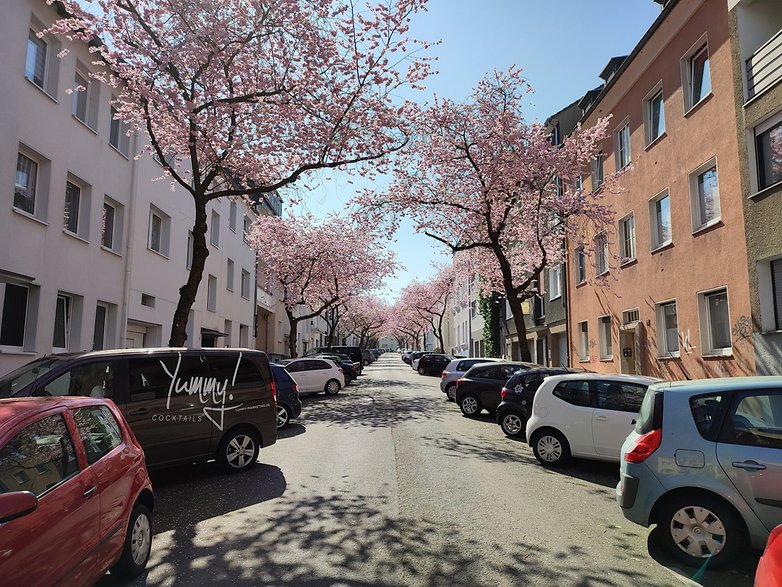
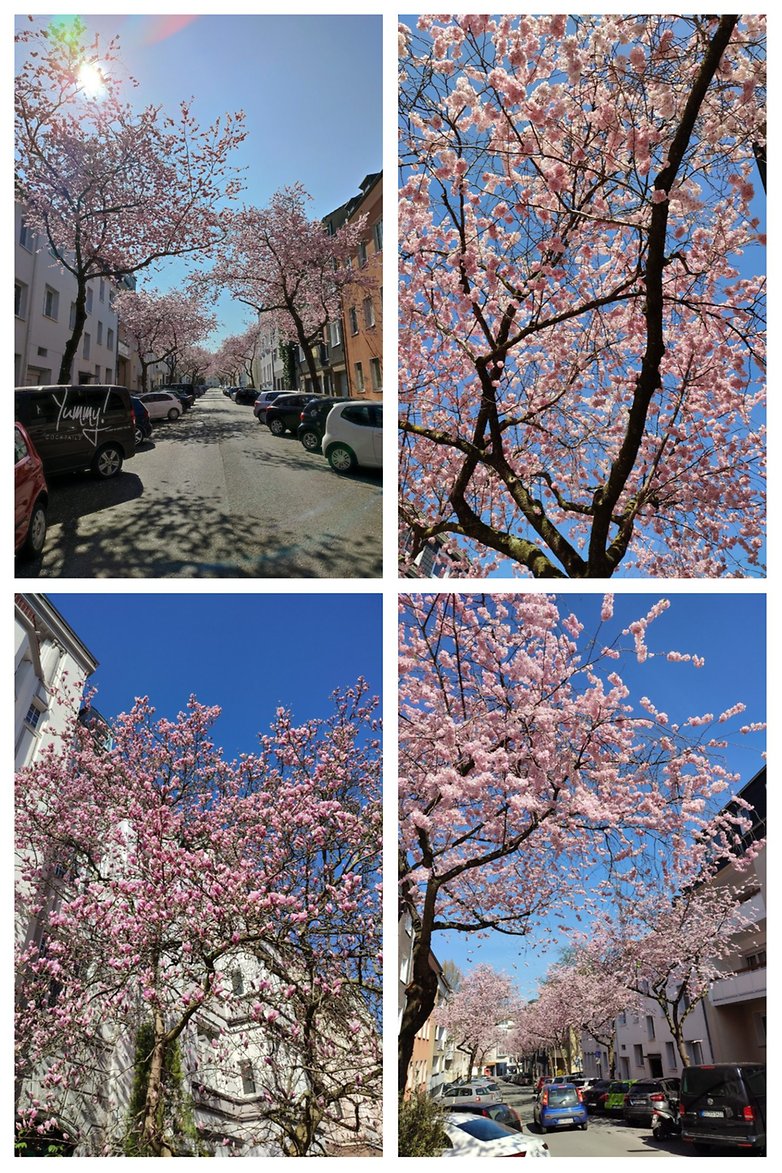
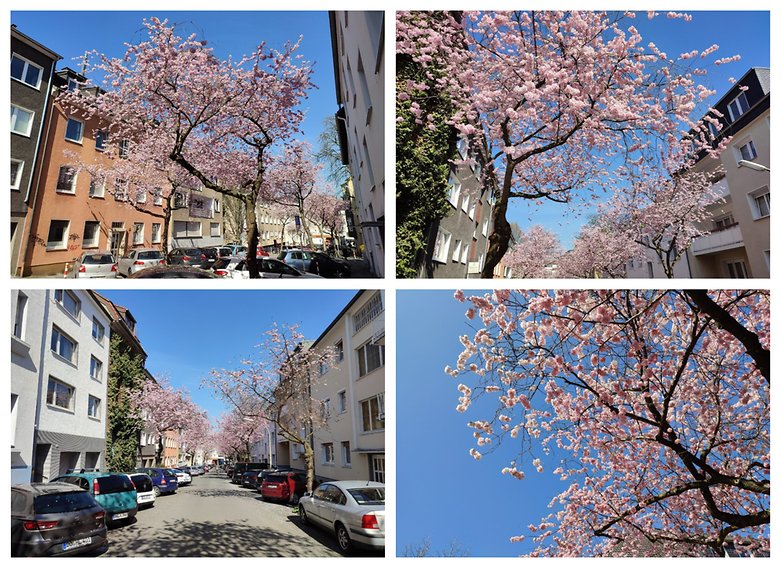

In the evenings, the results were mixed from time to time, but hey - that's the lot of mid-range cameras, isn't it? Nonetheless, you can snap fabulous photos here as well, especially with the night mode turned on, which also doesn't brighten up the images in an abnormal manner as we've sometimes seen on other cheaper smartphones.

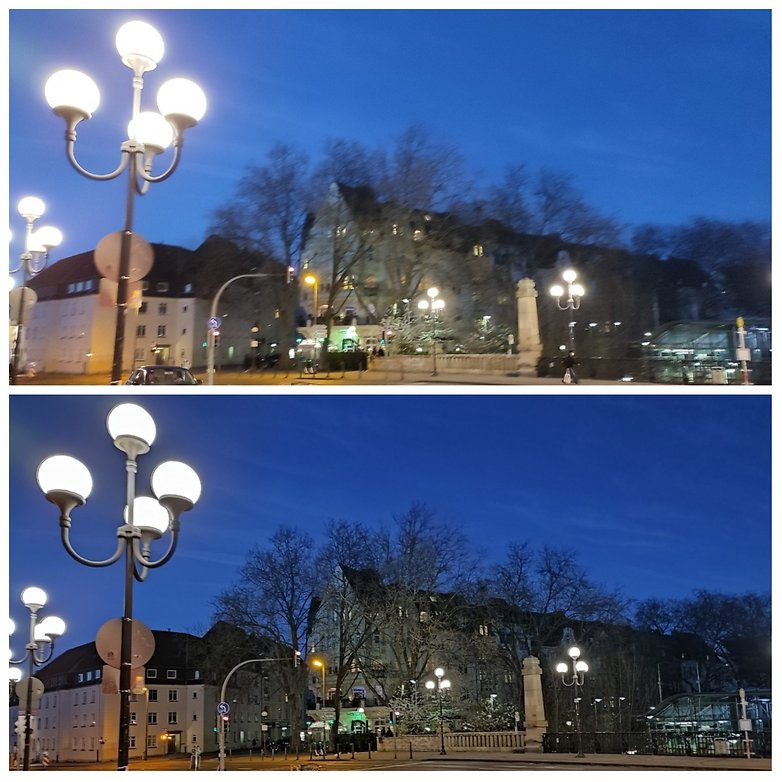



While I'm still deciding if my Sesame Street gag concerning macro photos will stick, we're approaching the worst section of the sample photos: Here are the selfie cam results:
Top left to bottom right:
- Red-faced normal selfie mode and Kim Jong-un combo Christ image.
- Red-faced portrait mode and blurry Kim Jong-un combo Christ image.
- Red-faced normal night selfie and a Kronen pilsner (Kronen tastes good!)
- Red-faced night selfie with flash and crown pilsner

Is the camera outstanding? No! Can you expect that for under €300? Of course not, my little dove! At this price, you will receive a versatile camera that is much more than a casual shooter, especially with the main camera that captures some very good photos under the right conditions.
Battery life
Battery
What I liked:
- 33-watt fast charging
- Long-lasting battery
What I didn't like:
- No wireless charging
Xiaomi has included a rather large 5,020 mAh battery into the 8.1mm-slim case and that was certainly not the worst idea considering the 120 Hz display that comes with it. The battery life was adequate enough throughout my review period, where it ought to last for two days before you run to the nearest power outlet. Of course, usage patterns are always subjective, and the same applies here. If you are a heavy user who plays games and watches videos all the time, don't expect it to last the entire day.
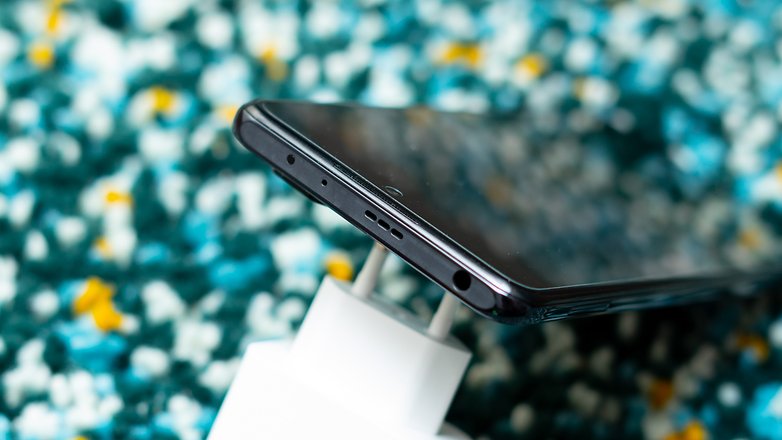
The included charger also ensures that you'll have enough juice quickly courtesy of its 33 watts fast charging capability. To charge it fully, it will take approximately 90 minutes from empty, which is slower than other smartphones. However, that is nitpicking at a very high level.
It's a pity that there is no wireless charging support, but hey, a company like Xiaomi has to cut corners somewhere, right?
Summary about the battery: Sufficiently large, charges fast enough.
Technical data
Technical data
| Xiaomi Redmi Note 10 Pro | |
|---|---|
| Processor | Qualcomm® Snapdragon™ 732G Qualcomm® Adreno™ 618 GPU |
| Memory and RAM | 6 GB + 64 GB | 6 GB + 128 GB | 8 GB + 128 GB LPDDR4X RAM + UFS 2.2 |
| Dimensions | 164 mm x 76.5 mm x 8.1 mm Weight: 193 g |
| Display | 6.67-inch AMOLED DotDisplay 2,400 x 1,080 FHD+ resolution 395 PPI Contrast ratio: 4,500,000:1 Brightness: HBM 700 nits, 1200 nits max. brightness DCI-P3 colour spectrum 8-bit colour HDR 10 Refresh rate: 120 Hz Sampling rate: 240 Hz Reading Mode 3.0 Sunlight Mode 2.0 SGS certification for eye-friendly display Tested SGS performance: Seamless Pro |
| Rear camera | 108 MP + 8 MP + 5 MP + 2 MP quad camera 108 MP wide-angle camera 0.7 μm-pixel, 9-in-1 to 2.1 μm-super pixel 1/1.52 inch sensor size f/1.9 8 MP ultra wide-angle camera FOV 118° f/2.2 5 MP telephoto macro camera f/2.4 AF Depth sensor with 2 MP f/2.4 Photo functions of the rear camera Long exposure mode with six effects (Moving crowd, Oil painting, Neon trails, Light painting, Starry sky, Star trails) Photo clones Night mode 2.0 108 MP mode Video functions of the rear camera Video clones Dual video ShootSteady Professional time-lapse video function Telemacro time-lapse video Video macro mode Rear camera video recording 4K 3,840 x 2,160 at 30fps 1080P 1,920 x 1,080 at 30fps/60fps |
| Front camera | 16 MP front camera f/2.45 Front camera photo features Night mode for selfies AI Beautify AI portrait mode with bokeh and depth control Front camera video features Time Lapse Front camera video recording 1,080 p, 1,920 x 1,080 at 30 fps 720 p, 1,280 x 720 at 30 fps Slow motion video: 120 fps, 720p |
| Battery and charging | 5,020 mAh high capacity battery Supports 33W fast charging |
| Security | Fingerprint sensor on the side of the bow AI face unlock |
| Network and connectivity | Dual SIM card NFC Supported network bands: 4G: LTE FDD B1/2/3/4/5/7/8/20/28/32 4G: B38/40/41(2.535-2.655 MHz) 3G: WCDMA B1/2/4/5/8 2G: GSM 850, 900, 1800, 1900 MHz Supported WLAN networks 2.4 GHz/5 GHz WLAN Bluetooth 5.1 Navigation and positioning GPS: L1 | Galileo E1 | Glonass L1 | Beidou B1 |
| Audio | Dual speaker 3.5 mm headphone jack High-Resolution Audio Certification High-Resolution Audio Wireless |
| Video | Supports HDR display when playing HDR10 video content |
| Sensors | Distance sensor | Ambient light sensor | Accelerometer | Electronic compass | Gyroscope | Linear vibration motor | IR blaster |
| Safe from splashes, water and dust | IP53 RATING |
| Operating System | MIUI 12 based on Android 11 |
| Package contents | Redmi Note 10 Pro/Adapter/USB Type-C cable/SIM eject tool/Soft protective case/User manual/Warranty card |
Anything else you should know?
Oh yeah, there were a few more things I noticed that I'd like to mention in closing:
- The stereo sound is quite loud and decent sounding for a mid-range handset
- There is now an IP53 certification, but it only protects against water splashes
- For all the curved display haters, yes, the display is flat!
- The charger is included
- Comes with Android 11-based MIUI 12 preinstalled
- There is annoying bloatware on board, but you can uninstall most of them fairly quickly
Conclusion
I'm going to go out on a limb and boldly say: Yep, THIS is a reference point when it comes to mid-range smartphones. For less than €300, Xiaomi lets you put a foot into flagship territory with the Redmi Note 10 Pro, and it is not only the display that impresses. From €279.90 and above, you get a real all-purpose device that will not let you down in terms of photography, gaming, or battery life.
As for its aesthetics, the protruding camera bump behind bothers me and you could still cite the lack of 5G support as a negative point, but like all the possible mentioned weaknesses on the Redmi Note 10 Pro, these are also just my subjective feelings and not really stumbling blocks. For those with small hands, perhaps the bulky 6.67-inch form factor might prove to be an uncomfortable hurdle.
All in all, here's what I can recommend you: Do you still have €300 left in your war chest and want to invest it in a smartphone? Then run to the nearest Xiaomi dealer and pick this up in full confidence. Throw the money at him and go home happy with the Xiaomi Redmi Note 10 Pro. I don't know about you but I, for one, am willing to grovel on my knees in dirt while paying homage to the new king of sub-€300 smartphones!
PS: Since I've taken it upon myself to unnecessarily over indoctrinate NextPit and its readership with Depeche Mode, I must admit that my efforts fell short in this review: I was listening to my Depeche Mode playlist comprising of post-Alan Wilder era songs most of the time while writing this review.



















After reading this article, I wonder (and not for the first time) what interests Internet tech reviewers the most about mobile phones: their seemingly unending gimmicks, or their actual usefulness at making and receiving telephone calls?
The Ixiaomi 8 I have is typical of the slavishness to gimmickry, with its functionality as an actual mobile phone predictably impaired as a result.
To answer an incoming call, I have to look for the small-print 'answer' text at the top of the display screen: WHY??? And if can't see that in the bright sunlight and keep bashing away at the screen until eventually, something happens (not sure what) and the phone now instructs me to swipe upwards TWICE. Again: WHY? By the time I've found a way of answering the call, the caller has rung off.
A nice clear simple big green button to touch called 'Answer' would presumably have been too simple for the superior brains behind the Xiaomi 8's design ever to have contemplated. To actually use the darn phone they'd designed after it has been manufactured must also have been too much of an effort, too.
As a result, not only do I find the Redmi Note 8 no more than a silly pre-pubertal icon, it has soured me against anything else from this manufacturer, whether or not a latest model has a camera that takes pictures in the dark or the time-wasting gimmickry of user-chooser variable refresh rates.
My wife remains seriously unimpressed too with Xiaomi; having used my Redmi 8 a couple of times, she's more than happy to continue on with her fully functional, easily pocketable Sony Ericsson K750i purchased as a Christmas present for her in December, 2006.
No, it doesn't show movies and no it doesn't allow her to play games. But then, it's a mobile phone. Something that easily and effectively allows her to receive and answer calls as well as make them.